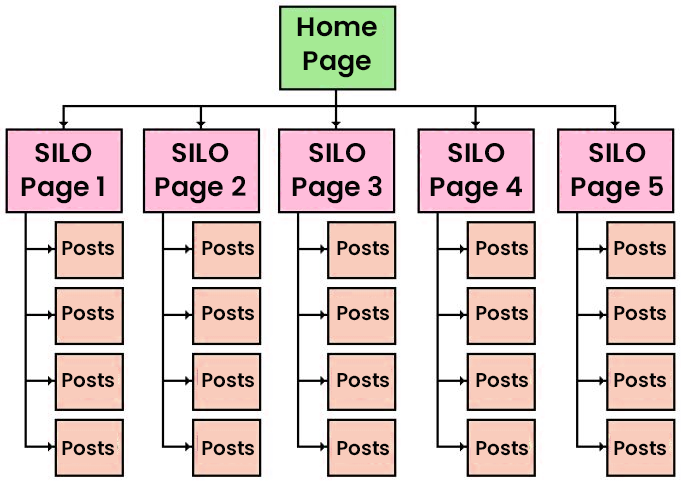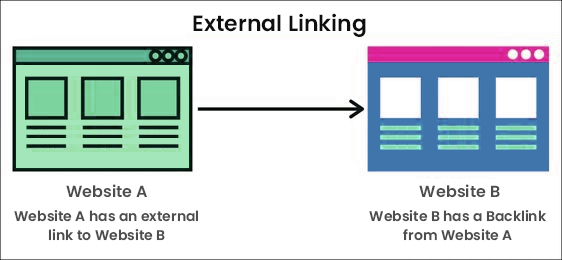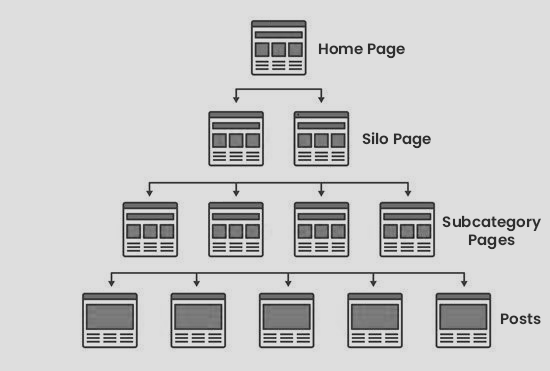Are you struggling to improve your website’s SEO performance? If so, consider implementing an SEO silo structure. An SEO Silo is a method for organizing content on websites that helps create internal linking opportunities and reinforces the connection between similar phrases or concepts used throughout the website. When properly implemented, this strategy can boost rankings and help search engines better determine which pages are relevant to specific keywords and topics. In this blog post, we’ll discuss how exactly an SEO silo structure works and why it’s important for improving your site’s organic traffic and visibility online.
Web crawlers have a very good understanding of silos and how to index them, so you can be sure that your pages will rise in the rankings of search engines and appear when someone types in a relevant keyword. As a result, you’ll be able to rank your pages higher in search results and improve your SEO. In this post, let us look deeply into the silo architecture, effective ways to do it, and steps to prevent any silo related issues. You may also look for an experienced digital marketing company that provides SEO services, to create these Silos for you.
What is Silo Architecture?
The process of grouping your content and backlinks in a way that makes it easier for Google to navigate your website is referred to as “silo structure”. Utilizing a storehouse structure keeps your site coordinated, which assists Google crawlers in finding your site without any problem. The goal of using a silo structure on your website is to give your customers a better experience by allowing them to easily move through the information. Additionally, it will help your website rank higher in search engine results.
Your site’s structure is closely examined by search engines to determine its primary topics and the quantity of keyword-supporting content. Within sections that pass PageRank, links are used strategically to reinforce these topics between pages that are closely related and landing pages. Google’s Panda algorithm, which rewards good content, can tell if your website is based on a bunch of targeted keywords and has useful content for users. This is why it’s so important to silo-structure your website.

Importance of Content Silos
Do you know that your website’s silo structure has the ability to draw any search engine bot to it? Your website’s silo-structured content can work magic to keep visitors on your site for a longer time. A website’s ranking on a search engine cannot be guaranteed. However, the content of your website is one thing you can be sure of. A content cluster, also known as a content silo, improves user experience and improves your website’s data structure.
At least five posts on each silo page of your website should help visitors delve deeper into the subject they’re interested in. They will eventually decide to take action and sign up for your services as a result of that. Your website’s silo strategy relies heavily on landing pages. Your website will dominate the search engine result page if you have the most effective silo strategy and content that uses effective and unique keywords.
How Silo Architecture Helps SEO?
There is no way to fully understand how or why a website is ranked by Google or any other search engine. However, there is a single, unmistakable message, which is that quality content must be provided by businesses. Your activities for creating content are supported by silo structures. Many online marketers consider creating content to be the most efficient SEO strategy. This indicates that the structure of your website will have a significant impact on the success of your content marketing. Let’s examine the various ways in which a silo architecture aids in search engine optimization.
User Experience
Even the tiniest flaw on your website can result in a large number of visitors hitting the back button when they first arrive. Content that is clearly organized should be one of your business website’s most important features. Customers will spend more time on your website if they can quickly see what it is about and where to find the information they need. Your website’s use of a silo structure will make navigation simpler and enhance the user experience.
Keyword Context
When indexing a website, search engines take into account how relevant a keyword is to the page’s content. Additionally, it takes into account the website’s context. To make sense, for instance, a blog post about a healthy salad needs to be in the category “recipes”. In addition, the blog post must fit the website as a whole. It could be a health and fitness related blog site in this instance. A recipe for salad should not be included in a post on a blog about home repairs. In order to improve your chances of being found online, you must incorporate keyword relevancy and context. Posts that are relevant to both the overall theme and the categories can be created by organizing your content in silos. When you create a suitable overarching context, you increase your chances of appearing for a keyword.
Backlinking and Interlinking
When building backlinks to your website, it’s critical to make sure they help visitors find content on the site. You can link posts in subcategories to posts in top categories using a silo structure, which can then link back to the home page. Because it makes it easier for search engine spiders to crawl your entire website, interlinking is beneficial. When your website is crawled, more relevant posts and articles are likely to be ranked for particular search terms.

Also, Read: SEO Tips- Guide To Cross Linking
Visible Content
With proper interlinking, you can increase the likelihood that search engines will ignore very little or none of the content on your website. Links are how search engines find more content on a website. Interlinking best practices recommend linking content only within a silo. This makes sure that your interlinks lead to content that is relevant and makes sense in the context. Linking to top-level categories is recommended if you must link to other silos.
Types of Silo Architectures
Silo structures can take many forms, including virtual and physical ones. The goal is to make content easier to understand and find by giving search engines a clear structure. To make it easier for customers to locate relevant products, many eCommerce websites employ silo structures. Silos can assist individuals in making sense of potentially overwhelming options. The development of silos can also be advantageous for online courses, forums, and membership sites. The creation of silos will assist in navigating multiple themes and topics in a digital course with gated content.
Physical Silo
A silo that you create in your website’s directory is known as a physical silo. The connections are made in a more concrete way with a physical silo. Basically, you will make envelopes on your site to address every one of your storehouses, and the pages inside the organizers are the supporting pages for the actual storehouse.
Uncountable amounts of data can be found on the internet. Every minute, about 380 new websites are created, each of which contains anywhere from one to thousands of pages. Since there is so much information available, it is nearly impossible for search engines to index each newly published page. The search engine is given a road map to follow by a physical silo. Adding links between pages emphasizes their connections even more. SEO silos aid in streamlining the process, but marketers still take other steps to get a page indexed.

Virtual Silo
By grouping related pages, separating unrelated pages, and strengthening the siloed landing pages, virtual siloing makes use of the internal link structure. Links between theme-related pages create a virtual silo, whereas physical siloing requires related pages to be in the same directory. By adding top-level parent pages and supporting children pages for each SEO silo, you consolidate topic relevance for a section of your website by linking closely related themes.
Site hierarchy is formed solely by linking patterns. Always establish a link between supporting pages and their silo landing page. With the exception of silo top landing pages, cross-links between silos should not be used. The theme would be weakened by randomly connecting silos. There should not be a link from a subpage in one silo to another silo.
Effective Silo Measures for Your Website
Putting together a silo structure takes a lot of time, but it also has a big effect on how well your SEO works as a whole. The four basic steps you’ll need to take are listed below.
Focus on Important Content
Identifying your website’s primary subjects is the first step in developing a silo structure.
For instance, if you run a healthcare company, you could separate your general medicine, emergency, and outpatient departments into their own silos. The next step is to group the pages you already have on these subjects. There will probably be a few pages that don’t fit into your established silos, which is fine for some of them. Your “About Us” and “Contact Us” pages, for instance, can remain in your root envelope. However, if you still have a lot of pages, look for common themes among them. This is an easy way to find more opportunities for your website’s content silos.
Also, Read: Google Helpful Content Update: Everything You Need To Know!
Ease of Navigation
You can organize the content of your website into distinct subfolders for each of the core topics once you have chosen them. Keeping up with the healthcare illustration from above, your folders would look like this:
www.yoursite.com/general-medicine/
www.yoursite.com/emergency/
www.yoursite.com/outpatient/
After that, arrange each of your pages in the proper folder. Therefore, if you had a page titled “viral fever” at “www.yoursite.com/fever/” that page would now be found at “www.yoursite.com/general-medicine/fever/”. Set up 301 redirects for each of your moved pages, update your site’s navigation to reflect the changes, and organize all of your pages into the appropriate folders.
Interlinking Architecture
Since links from other websites are a big indicator of authority to search engines, many SEOs only focus on getting them. Internal links, on the other hand, are crucial for assisting search engine crawlers in determining the connections between your pages. Include links between the pages in each individual silo wherever needed. This demonstrates to search engines that each of these pages has a connection to the others and that your website provides extensive information about their subject. Because they make it simple to find information that is related, these links also increase the likelihood that visitors will remain on your website and learn more.
- Strengthen Content in Silos
After you reorganize the pages on your website, the process of creating SEO-friendly silos continues. Providing comprehensive coverage of your silo topics ought to be your objective. Look over the pages in each group to see if any information is missing, and then use these as ideas for new pages. You can then conduct keyword research to find additional opportunities for each silo. Your content marketing strategy should include this as a key component and an ongoing process. You demonstrate to search engines that you are an authority on the subjects you have chosen as you continue to add new pages to each of your silos.
Reorganize Website Architecture for Silo
Be cautious when converting your site’s structure into a physical silo. Changing a website’s URL can hurt or stop all traffic to an existing page. This is especially true if that page has a lot of links to it. Your quality score will suffer as a result of the links now appearing broken, which could frustrate potential customers. For existing web pages, a virtual silo is frequently the most effective strategy. A virtual silo would not alter your URL structure while a physical silo could be used for new pages. You could update some of the content and repost it with a new URL if some of your existing pages aren’t getting much traffic. You could also move the content and make a link to go to a new URL from the old one.
Downside of Silos
It is possible to negate the advantages of using silos and make your pages harder to find rather than easier to find if you isolate content within silos in a way that makes it difficult to find them. A specific piece of content can only be accessed by going directly down from top-level pages. As a result, there is a greater chance that they will miss pages that may have piqued their interest across silos. Users will be unable to move between silos on a website that restricts its silo architecture to a hierarchical configuration. Users who are determined to locate specific information they anticipate on a website may resort to Google searches rather than site navigation. This is a clear indication that a website’s structure does not contribute to a positive user experience.
How to Prevent Silo Issues
Even though Siloing structure is at a disadvantage when it comes to cross linking, it can not be completely disregarded as a failure model. Instead, to use the silo structure without its demerits there are a number of best practices that you can follow while organizing your website. This will help you overcome the defect and at the same time will allow you to reap all the benefits of a good SEO silo architecture. Let us take a look at those best practices.
Easy Content Search
Google can find and index your content as long as it has internal links. The issue is that Google might not give the crawling or indexing of deep content any priority because it might think that searchers won’t care much about it. Because of this, you need to make sure that important content doesn’t get lost in the depths of your site. The depth probably should not be a problem for not so important pages. However, if we observed significant posts or pages, we might think about constructing pertinent internal links to them from other content that is higher up in the hierarchy of our website.
Create Content Hubs
Because it is published chronologically, blog content typically lacks contextual hierarchy. This can be resolved by constructing content hubs from related posts. Similar to silos, content hubs are collections of related content that are interconnected. The fact that you are free to link between content hubs is the only real difference between silos and hubs.
Let’s say, for instance, that we have two content hubs: one on cakes and the other on pastries. It may make perfect sense to internally link from the red velvet post to the cakes hub page. With content hubs, unlike with siloing, there is no restriction on what you can do. In fact, content hubs offer the best of both worlds to you. Similar to silos, related content is grouped and interlinked, but you can also link between pages internally if it makes sense.
Pyramid Architecture
The pyramid structure of your website places your most important content first, followed by your second and third most important content, and so on. The majority of websites are structured this way. There are various advantages of a pyramid site structure. It is very easy to use where visitors begin on the homepage, select a category, and then delve further. It also has good page rank flow. Since site homepages typically receive the most backlinks, it makes sense to have important content close by. Contextual internal links link categories to their subcategories and vice versa. You will notice that these three advantages roughly correspond to the perceived advantages of silo structure. It simply does not have the drawback of restricting internal connections between silos.
Visitor Experience
Instead of blindly adhering to SEO techniques, create layers and silos with the user in mind and ensure that humans, not machines, have a positive website experience. You will not succeed in SEO if you lack human experience. Keep in mind that usability and a positive website experience should take precedence over SEO. Make sure that users can only click three links from the homepage to get to any part of your website. This makes it easy for search engines to crawl your website and improves the user experience.
Final Thoughts
The best way to organize the content on your website is with an SEO silo structure. Although implementing a silo structure can be difficult, it will assist search engines in better crawling, indexing, and ranking your website. A topic-specific page and supporting content pages will demonstrate to search engines your relevance to the subject, resulting in a higher ranking. By distributing authority across the pages, internal linking within a silo structure significantly improves search engine optimization.
You now know how to use silos to effectively structure your website. You also know why it’s important to your keyword rankings and search engine rankings, which models you can use, and how to use the right one on the right website. If you decide to implement a domain directory structure on your website, you also know how to reinforce your link silos. If you achieve those objectives, your website will be more relevant and powerful, and its keyword rankings will improve for even the most specific topics. It will also assist visitors in better comprehending your website.
FAQs
Is Silo structure compulsory for a website?
It may not be compulsory but silo structure is one of the most successful architectures you can use for your website for better results.
Is siloing a website difficult?
Siloing is easy at the beginning where you only need to categorize your inventory but as you proceed there are some SEO techniques that need attention, which can be done only by a SEO expert.
Is there a drawback to siloing?
Even though siloing has a single drawback of cross linking, there are numerous ways to counter it, as provided above.
























